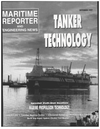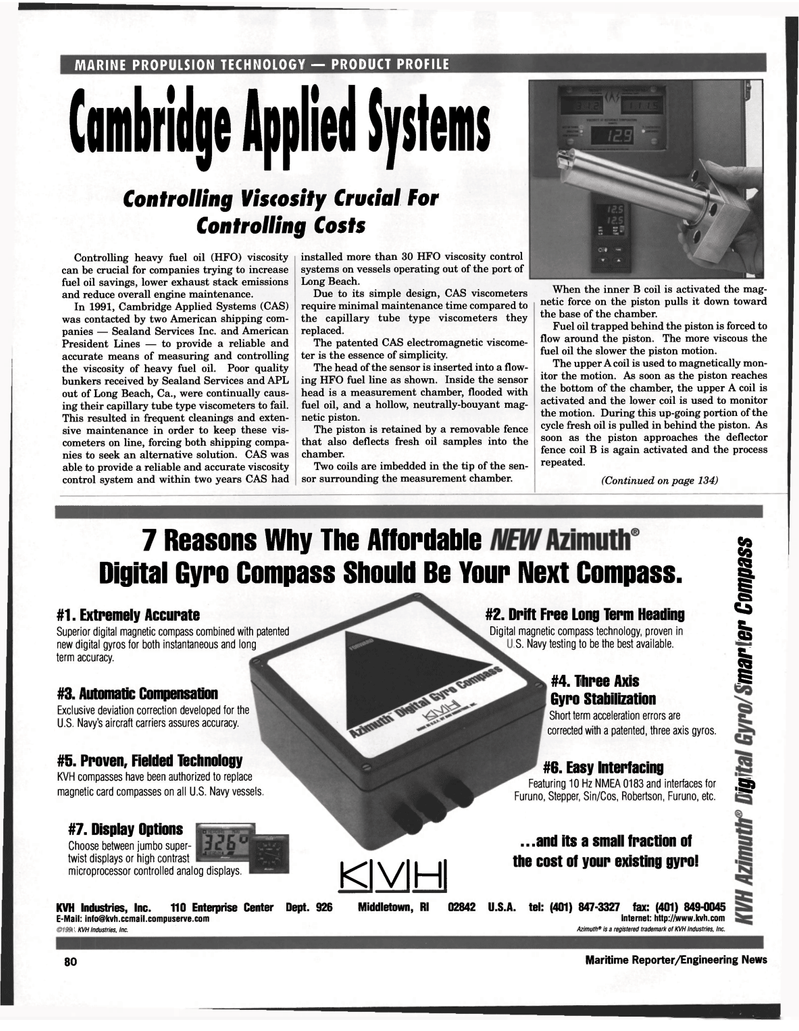
Page 80: of Maritime Reporter Magazine (September 1997)
Read this page in Pdf, Flash or Html5 edition of September 1997 Maritime Reporter Magazine
MARINE PROPULSION TECHNOLOGY — PRODUCT PROFILE
Cambridge Applied Systems
Controlling Vistosity Crucial For
Controlling Costs
Controlling heavy fuel oil (HFO) viscosity can be crucial for companies trying to increase fuel oil savings, lower exhaust stack emissions and reduce overall engine maintenance.
In 1991, Cambridge Applied Systems (CAS) was contacted by two American shipping com- panies — Sealand Services Inc. and American
President Lines — to provide a reliable and accurate means of measuring and controlling the viscosity of heavy fuel oil. Poor quality bunkers received by Sealand Services and APL out of Long Beach, Ca., were continually caus- ing their capillary tube type viscometers to fail.
This resulted in frequent cleanings and exten- sive maintenance in order to keep these vis- cometers on line, forcing both shipping compa- nies to seek an alternative solution. CAS was able to provide a reliable and accurate viscosity control system and within two years CAS had installed more than 30 HFO viscosity control systems on vessels operating out of the port of
Long Beach.
Due to its simple design, CAS viscometers require minimal maintenance time compared to the capillary tube type viscometers they replaced.
The patented CAS electromagnetic viscome- ter is the essence of simplicity.
The head of the sensor is inserted into a flow- ing HFO fuel line as shown. Inside the sensor head is a measurement chamber, flooded with fuel oil, and a hollow, neutrally-bouyant mag- netic piston.
The piston is retained by a removable fence that also deflects fresh oil samples into the chamber.
Two coils are imbedded in the tip of the sen- sor surrounding the measurement chamber.
When the inner B coil is activated the mag- netic force on the piston pulls it down toward the base of the chamber.
Fuel oil trapped behind the piston is forced to flow around the piston. The more viscous the fuel oil the slower the piston motion.
The upper A coil is used to magnetically mon- itor the motion. As soon as the piston reaches the bottom of the chamber, the upper A coil is activated and the lower coil is used to monitor the motion. During this up-going portion of the cycle fresh oil is pulled in behind the piston. As soon as the piston approaches the deflector fence coil B is again activated and the process repeated. (Continued on page 134) 7 Reasons Why The Affordable
Digital Gyro Compass Should Be Your Next Compass. #1. Extremely Accurate
Superior digital magnetic compass combined with patented new digital gyros for both instantaneous and long term accuracy. #3. Automatic Compensation
Exclusive deviation correction developed for the
U.S. Navy's aircraft carriers assures accuracy. #5. Proven, Fielded Technology
KVH compasses have been authorized to replace magnetic card compasses on all U.S. Navy vessels #7. Display Options
Choose between jumbo super- twist displays or high contrast microprocessor controlled analog displays. KlY|H| #2. Drift Free Long Term Heading
Digital magnetic compass technology, proven in
S. Navy testing to be the best available. #4. Three Axis
Gyro Stabilization
Short term acceleration errors are corrected with a patented, three axis gyros. #6. Easy Interfacing
Featuring 10 Hz NMEA 0183 and interfaces for
Furuno, Stepper, Sin/Cos, Robertson, Furuno, etc. ...and its a small fraction of the cost of your existing gyro!
KVH Industries, Inc. 110 Enterprise Center
E-Mail: [email protected]
Dept. 926 Middletown, Rl
CO
I i
Cd & i •5? i KVH Industries, Inc. 02842 U.S.A. tel: (401) 847-3327 fax: (401) 849-0045
Internet: http://www.kvh.com
Azimuth® is a registered trademark of KVH Industries, Inc. 80 Maritime Reporter/Engineering News

 79
79

 81
81
